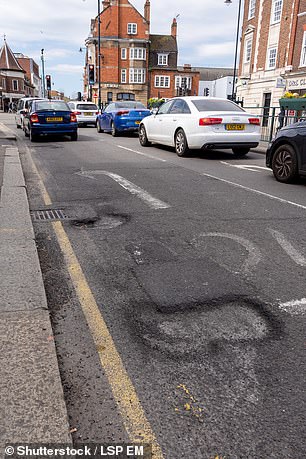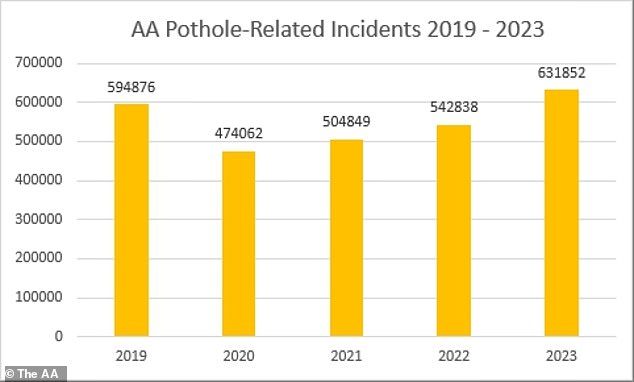
Motorists in Britain forked out almost half a million pounds to fix their vehicles due to damage caused by potholes last year, a new coalition of motoring groups has estimated
Motorists forked out almost half a billion pounds in 2023 repairing damage to their vehicles caused by Britain’s pothole-blighted roads.
A new coalition of motoring groups, experts and manufacturers estimates that drivers paid a staggering £474,000,000 last year to fix issues caused by clattering through a crater in the road.
The AA, which is one of the members of the newly-formed Pothole Partnership, said it had received 632,000 call outs to vehicles damaged by road defects last year – a 16 per cent increase compared with the previous 12 months.
Scroll down to read our five-step guide to making a claim for pothole damage compensation.
AA president Edmund King said: ‘We often have a vicious circle of: pothole formed; damage caused; pothole patched; pothole reappears with more damage caused. What we need are more permanent repairs.’
The motoring group said of the 632k pothole-related incidents its patrols attended in 2023, its workforce dealt with a range of tyre, wheel, steering, and suspension damage – and that’s just its members.
If rounded up on a national scale, the breakdown recovery provider believes around 2million vehicles were affected by poor road maintenance last year.
With Britain braced for another big freeze this week, wet conditions and a plummet in temperatures is only likely to worsen the nation’s pothole problem.
Potholes are commonly caused by water seeping into existing small cracks in the surface of the road caused by the wear and tear of traffic and deterioration over time.
Cold weather then causes this water to freeze and expand.
When this water melts and evaporates when temperatures rise again, it creates gaps which then get broken down by the motor traffic.

The AA says its patrols in 2023 went out to 16% more pothole-related breakdowns than the yeaer previous

With Britain set to be hit by another cold snap this week, the plague of potholes on our roads is likely to worsen
The cost of clearing Britain’s pothole backlog was estimated last year to cost a record £14billlion, with the estimated repair bill increasing by nearly £1.5billion on the year previous.
The Asphalt Industry Alliance (AIA) said in March it would take 11 years for local authorities to fix every crumbling road in England and Wales, up from nine years in 2022.
The AIA’s Annual Local Authority Road Maintenance (ALARM) report found there were 8,000 fewer miles of road classified as ‘good’ compared with last year, a fall of 4 per cent.
The Pothole Partnership – officially announced on Monday morning to mark National Pothole Day – has the primary objective of finding solutions to tackle Britain’s crumbling road conditions.

AA president Edmund King (pictured) believes Britain’s drivers are stuck in a vicious circle of operators failing to fix potholes correctly. ‘What we need are more permanent repairs,’ he said
Its first act is to send a five-point plan to central and regional government officials demanding more effective road repairs and full transparency from local authorities on their progress in tackling the backlog of remedial work.
Mr King added: ‘Potholes are the number one concern for 96 per cent of drivers and can be fatal for those on two wheels so hopefully pressure from the Pothole Partnership will lead to permanent repairs.’
Cllr Darren Rodwell, transport spokesperson for the Local Government Association, responded to the five-point pledge, stating: ‘Councils share the concerns of all road users with the state of our roads and are doing all they can to tackle the £14billion backlog of road repairs, including learning from and adopting innovative techniques.
‘Greater, long-term and year-on-year consistency of funding for the maintenance of all parts of our highways will help them achieve this.
‘The Government should award council Highways Departments five-yearly funding allocations, to bring them on a par with National Highways, to give more certainly so they can develop resurfacing programmes and other highways improvements, to help them tackle the scourge of potholes.’
Other members of the Pothole Partnership include the National Motorcyclists Council, British Cycling, IAM RoadSmart, the British Motorcyclists Federation and pothole repair machine manufacturer JCB.
The British heavy-machinery manufacturer’s £!65,000 Pothole Pro is an award-winning digger conversion created specifically to fix potholes efficiently and effectively.
It is a unique three-in-one solution with dedicated tools to cut, crop and clean and damaged road area.
It means there’s no need for additional specialist equipment or extra manpower, saving both time and money.
It can repair a typical pothole in just eight minutes and provides a permanent fix.
This is Money had an exclusive first-hand look at the PotholePro in action in early 2022, where we pitted the bright yellow digger against a traditional road repair team.
The two went head-to-head to fix four potholes in a 12 square metre section of one crater-riddled street.
The total repair time, including completely resurfacing the damaged section, took the PotholePro team 45 minutes and 11 seconds.
The traditional ‘hand lay’ team took 2 hours 16 minutes and 11 seconds in comparison.
The RAC has also made an announcement on National Pothole Day that it has joined forces with technology company Metricell to encourage drivers to use a new mobile app named Stan to automatically collect data on road conditions via smartphone cameras.
Metricell will share the information it receives with highways authorities.
RAC head of policy Simon Williams said: ‘Potholes are so much more than an irritation – they are a very serious danger to all road users, which we fear will only get worse as the weather gets colder during these next few months.’
RAC patrols attended 30,000 pothole-related breakdowns over the course of the year, up by a third (33 per cent) on 2022.
Roadside patrols at the motoring services company went out to 29,377 breakdowns in 2023 – the equivalent of 80 breakdowns a day.
In November, Prime Minister Rishi Sunak pledged to tackle the scourge of potholes with an extra £8.3billion of funding over 11 years for local roads maintenance in England using money saved by scrapping HS2 north of Birmingham.
New car owners not armed to cope with pothole punctures

Your new car is very unlikely to have a spare wheel: Analysis of 313 models on sale in showrooms currently – ranging from the smallest superminis to the largest 4x4s – found only 8 come with a back-up wheel in the boot as standard
Breakdown assistance providers confirm that the most common damage caused by potholes is punctured tyres.
However, new cars sold in dealerships today are not equipping drivers with the essential tools to continue a journey after suffering from a flat tyres.
Market analysis conducted in November found that just 3 per cent of new motors sold in showrooms today come with a spare wheel as standard.
With car makers instead eliminating full-size and space-saver spare wheels in favour of lighter and cheaper tyre repair kits, there is an increased change of motorists being stranded at the roadside if they get a puncture.
The RAC reviewed 313 new cars on sale – ranging from the smallest superminis to the largest 4X4s – and found that only eight (2.6 per cent) come factory-fitted with a back-up wheel in the boot.
The breakdown assistance provider says this is causing a ‘dramatic’ rise in the number of incidents where drivers need help in the event of an unrepairable flat tyre.
Its patrols went out to nearly 200,000 call-outs last year where drivers had a puncture and no spare wheel, up from 165,000 in 2018.
The motoring group said it is predominantly larger, heaver-duty vehicles that come with a spare wheel, meaning the vast majority of family-friendly cars won’t have them as standard.
Many manufacturers have stopped including a spare wheel as standard to reduce the weight of their cars by up to 20kg.
This makes the vehicles more fuel efficient but also helps car makers to meet tougher emissions legislation.
Tyre repair kits are also far cheaper to offer as standard equipment in cars, meaning manufacturers can save money on each model they sell by not offering it with a spare in the boot or under the chassis.
It means buyers will almost always have to pay extra to have the convenience of a spare wheel in the boot.
Potholes partly causing spike in motor premiums
The pothole issue is one that’s not just costing motorists money at repair centres and garages – it is stinging their premiums too.
Despite the deteriorating state of the nation’s roads, only 1.4million potholes were filled in 2022/3, down from 1.7million in the previous year.
The AIA’s found shortfalls in pothole repair budgets among local authorities had reached a record high.
Councils in England and Wales said they only received two-thirds of what they needed during the current financial year to stop local roads further deteriorating, the ALARM survey found.
Meanwhile, the compensation paid out for accidents and damage caused by poorly maintained roads has risen from £8.9million to £11.6million – despite the number of submitted claims falling.

The total number of potholes filled reported in this year’s survey has decreased by 16 per cent from 1.7million reported for the last two years to 1.4million in England and Wales

The total shortfall in carriageway maintenance budgets reported in England and Wales was £1.3bn in 2023, equivalent to a funding gap of £7.7m per authority – a 20% rise on 2022

The total amount paid in claims has risen by 30% to £11.6million, the AIA said last year
Earlier this month, it was revealed by the UK’s largest car insurer that the number of pothole claims has risen 40 per cent in a year.
Admiral said it received a record 1,324 claims for car damage due to potholes in 2023, an increase from 946 in 2022.
The insurance firm’s previous record year for potholes was 2018, with 1,057 claims, largely due to the ‘Beast from the East’ storm damaging roads.
The average pothole claim payout also rose by almost a third in 2023 when compared to 2022, from £2,378 to £3,070.
Admiral said the increase is due to modern vehicles being more complicated to repair, and therefore more expensive.
The insurance firm also said pothole payouts were rising due to vehicle repair costs rising generally.
Adam Gavin, head of claims at Admiral, said: ‘Potholes are more than just an inconvenience, they can also cause costly damage to your vehicle.
‘January, February and March are the worst time of year for pothole claims, with more than a third of claims we receive made over this period, as road surfaces become unsettled by freezing temperatures and thaws.’
Some links in this article may be affiliate links. If you click on them we may earn a small commission. That helps us fund This Is Money, and keep it free to use. We do not write articles to promote products. We do not allow any commercial relationship to affect our editorial independence.




